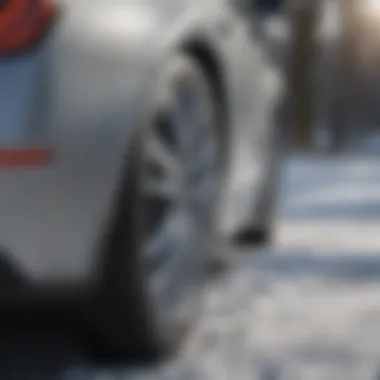In-Depth Review of Bosch Winter Blades Performance


Intro
As winter approaches, one can almost feel the chill setting in, bringing with it the annual struggle of driving in snow and ice. For any driver, the necessity of reliable wiper blades becomes paramount, especially when navigating through adverse conditions. Among the options available in the market, Bosch winter blades have carved a niche, drawing attention for their design and functionality. This article aims to unfold the intricacies surrounding these vital automotive accessories, providing valuable insights for both enthusiasts and potential buyers alike.
For automobile aficionados, understanding the performance of these blades in snowy and icy weather can transform a potentially hazardous drive into a manageable one. From variations in design to the effective maintenance strategies necessary to prolong their lifespan, each aspect plays a vital role in ensuring safe travels during the winter months. Armed with knowledge regarding Bosch winter blades, readers will be better equipped to make informed choices that mesh with their unique driving needs and preferences.
Foreword to Bosch Winter Blades
In the realm of automotive care, the significance of quality wiper blades stands tall, especially during winter months when visibility can be sharply compromised by snow, ice, and rain. Bosch winter blades are engineered with a distinct focus on coping with the challenges that harsh weather brings, setting them apart from general-purpose options. This article will delve into the myriad aspects of Bosch winter blades, emphasizing their unique attributes, user benefits, and the rationale behind selecting them for winter driving.
Overview of Wiper Blades
Wiper blades, though often overlooked, play a critical role in ensuring safe driving conditions. They clear away elements that obstruct a driver's view, including rain, snow, and road debris. The basic design consists of a rubber blade attached to a metal or plastic frame that enables flexible movement across the windshield. However, not all wiper blades are created equal; many factors influence their effectiveness, including the materials used and their specific design features.
Today, alternatives span from traditional conventional blades to modern beam designs, each claiming specific advantages. Particularly in winter, the demands on wiper blades rise dramatically. Regular blades might falter under the burden of ice and snow, leading to less effective performance and even possible damage to the vehicle's glass surface. Thus, understanding the variety and distinctiveness of winter blades becomes pivotal for drivers looking to maintain both safety and visibility during the colder months.
Why Choose Bosch?
Bosch has carved out a reputation in the automotive world for reliability and quality. Their winter blades offer a number of thoughtful design innovations that address the common shortcomings of standard wiper blades. Here’s why many drivers find Bosch the go-to choice:
- Engineering Excellence: Bosch invests heavily in research and development to craft products that withstand extreme conditions. Their winter blades come with advanced materials designed to resist cracking in the cold.
- Performance in Adverse Weather: Users report that Bosch winter blades provide superior wiping action, even when facing significant snow and sleet. This is largely due to features such as enhanced blade curvature, which maintains contact with the windshield.
- Durability: Bosch refers to their blades as weather-smart, employing designs that not only perform but also last longer than many competitors, cutting down on the frequency of replacements.
It's worth noting that while other brands may offer similar products, the specific attention to winter challenges and the blend of technology and practical need make Bosch a notable contender in this market. In a field where visibility can mean the difference between safety and disaster, investing in the right wiper blades could be one of the most important choices to ensure that your driving experience remains uninterrupted.
The Science Behind Winter Wiper Blade Design
The design of wiper blades during winter months is no small potatoes. As cars navigate through ice, slush, and snow, the capabilities of the wiper blades truly come to light. Understanding the science behind their design is paramount for ensuring visibility and safety on the road. In this section, we will dissect the elements that contribute to the efficiency of Bosch winter blades, with a particular focus on material innovations and aerodynamic efficiency.
Material Innovations
Rubber Composition
Rubber is one of the most crucial materials in the making of wiper blades. With Bosch winter blades, the use of specially formulated rubber makes a significant difference. This composition is engineered to withstand the harsh conditions that winter presents. The key characteristic here is its elasticity; it allows the blades to make consistent contact with the windshield, which is essential for effective cleaning.
One of the unique features of Bosch's rubber composition is its resistance to cracking. When temperatures plummet, traditional rubber can become brittle, leading to subpar performance and premature wear. Bosch, however, utilizes a blend that retains its flexibility even in frigid conditions. This not only enhances the lifespan of the blades but ensures they perform optimally throughout winter, offering advantages that are hard to overlook.
Durability Features
Durability features play a significant role in ensuring wiper blades can withstand the rigors of winter driving. Bosch has installed advanced engineering methods to ensure that their wiper blades maintain performance longer than competitors'. The rubber used is not just about fit but also the technology infused in it.
A standout characteristic of Bosch winter blades is their sturdy frame design, which supports the blade in resisting ice build-up. This means less time scraping ice off your windshield and more time focused on the road ahead. Additionally, the unique coating offered in these blades helps minimize wear due to friction, ensuring functionality even under heavy use. Thus, the durability of these blades becomes a significant asset for drivers seeking reliability every winter.
Aerodynamic Efficiency
The design of Bosch winter blades isn't marked merely by the materials used but also by one important consideration: aerodynamics. Properly structured wiper blades reduce air resistance, which can be crucial during a storm when visibility is compromised. The aerodynamic shape of Bosch blades works to keep them pressed against the windshield at high speeds, ensuring no streaks are left behind as they wipe away the snow.
Additionally, this form helps prevent lift, which can occur in fast-moving vehicles and could lead to blades becoming less effective. The result? A consistently clear view, allowing you to face those winter roads with confidence. In essence, when we talk about aerodynamic efficiency, we’re not just padding words; we’re referring to a practical benefit that plays a key part in safe driving conditions during the chilling months of winter.
"Investing in Bosch winter blades is like putting up a comforting shield between you and the icy elements — visibility is your ally on the road."
Types of Bosch Winter Blades
When it comes to ensuring visibility during bleak winter conditions, the type of wiper blade you choose can make all the difference. Bosch offers a range of winter blades designed to cater to varying needs and preferences. This section will dive into the specific types of Bosch winter blades, highlighting the nuances that make each option worthy of consideration. Understanding these differences helps drivers maintain clear vision on those frosty mornings when the roads could be treacherous.
Conventional vs. Beam Blades


Performance Comparison
When comparing conventional and beam blades, one thing stands out: their ability to adapt to various weather conditions. Conventional blades, typically composed of a rubber strip attached to a metal frame, excel in snow and light rain. However, they are often found wanting when temperature dips lead to ice buildup. In contrast, beam blades use a more streamlined design without the external framework, allowing them to make consistent contact with the windshield.
This consistent contact can be a game changer during heavy snowfall, as air pressure helps them maintain a grip on the glass surface. Beam blades’ unique feature—their design—ultimately contributes to their overall effectiveness and durability. Most drivers who have switched to beam blades observe a noticeable improvement in cleaning performance, making it a popular choice for those navigating icy roads.
A key characteristic of this performance comparison is durability. Beam blades tend to last longer without deteriorating from exposure to the elements. This longevity makes them not just a sound investment but also a practical one, especially for regions prone to snow and extended winter.
User Preferences
User preferences in wiper blade selection are often influenced by a mix of personal experience and recommendations. Many drivers report that they lean toward beam blades due to the ease of installation and the performance they've come to expect. The seamless integration with the windshield is appealing, particularly for those who prioritize safety in adverse conditions. Often, these users find themselves in situations where visibility dictates driving safety, making their choice all the more important.
On the flip side, there are still loyal fans of conventional blades. Some users appreciate how they are generally easier to find in stores and may prefer the familiar design. They're usually more affordable and might serve adequately for places where heavy snowfall is rare. A distinguishing feature is that they are often easier to replace if one section of the blade wears out—a practical consideration for many shoppers.
Hybrid Options
When exploring hybrid options, it becomes clear that Bosch aims to revolutionize winter driving safety by combining the best aspects of conventional and beam blades. These hybrid blades often have a robust frame with flexible components, offering the best of both worlds—strong performance in various weather conditions and durability. Drivers appreciate that hybrid blades often have additional features such as protective coatings that reduce ice accumulation and wear from harsh conditions. This can be especially reassuring for drivers who encounter both rain and snow during winter months.
Overall, whether you opt for conventional, beam, or hybrid blades, it is essential to make a choice that fits your driving habits and the typical weather conditions in your area. Each type has its advantages and trade-offs, meaning understanding these options allows drivers to make an informed decision that supports safety and performance on the road.
Key Features of Bosch Winter Blades
When it comes to navigating the winter months, having reliable wiper blades becomes essential for clear visibility and safe driving. Bosch winter blades are engineered with specific features that address the unique challenges posed by harsh winter conditions. By focusing on these critical aspects, drivers can enhance their overall experience, ensuring their wipers perform at their best when it matters most. Let's delve into the key features that set Bosch winter blades apart.
Winter-Specific Technologies
Enhanced Cleansing Action
The Enhanced Cleansing Action of Bosch winter blades significantly impacts their overall performance. This feature is primarily characterized by the ability to effectively remove not just water, but also ice, sleet, and snow. Traditional wiper blades often struggle to handle the accumulation of winter debris. However, Bosch blades incorporate advanced rubber compounds and specialized edge designs that grip the glass better, ensuring that the blades maintain optimal contact with the windshield.
What makes this cleansing action a popular choice is its effectiveness in diverse weather conditions. Drivers often appreciate that they can trust their wiper blades to perform, even in less-than-ideal circumstances. The unique formulation in the blade's composition means they can stretch and bend without losing their shape, which enhances their ability to clear the surface.
However, it is not all sunshine and rainbows. Some users report that the softer rubber meant for this enhanced action can wear down quicker if used on heavily textured or dirty surfaces. Therefore, understanding when and how to use these blades contributes to maintaining their longevity and effectiveness.
Better Ice and Snow Resistance
Another crucial aspect of Bosch winter blades is their Better Ice and Snow Resistance. These blades are specifically designed to combat ice buildup on the wiper itself, a common frustration faced by drivers during heavy snowfalls. The blades feature a thermoplastic rubber that stays flexible even in cold temperatures. This flexibility allows the blades to adapt to the windshield contours, ensuring they don’t freeze in position.
The standout feature of this resistance is its unique ability to shed snow and ice more effectively than standard blades. This means that even after a storm, drivers can expect their wipers to perform admirably without frequent stoppages for clearing the blades. The obvious benefits are clear visibility and a reduction in distractions — two vital factors for any driver.
On the flip side, while the material does provide excellent resistance, it can sometimes lead to a slightly noisier operation when in use, especially on dry or warmer surfaces. Still, the trade-off in enhanced performance during winter makes these blades a worthwhile investment for those in colder climates.
Installation and Fitment
The ease of installation and fitment of Bosch winter blades can't be overlooked. They come equipped with user-friendly features that allow for quick attachment to various vehicle models without requiring a mechanic's expertise. Given the variety of wiper arm types found in cars today, Bosch caters to this with different adapter options included in the packaging. This flexibility ensures that even a novice can replace their wiper blades efficiently, which is a huge time-saver when winter weather hits unexpectedly.
Furthermore, proper fitment is crucial for wiper blade performance. Bosch provides detailed instructions and compatibility information, making it easier for buyers to select the right model. The snug fit not only improves performance but also extends the lifespan of the blades, as they are less prone to wear caused by improper fitting.
In summary, the key features of Bosch winter blades, including their specialized technologies and ease of installation, position them as a top contender in the winter wiper market. These elements not only enhance driver safety but also contribute to a more enjoyable winter driving experience.
Performance Analysis
Analyzing the performance of Bosch winter blades is crucial for understanding their effectiveness in challenging weather conditions. This section aims to dissect user experiences and expert insights, allowing potential buyers to gauge the reliability of these wiper blades. Insights derived from performance analysis serve as a vital resource in determining not just the quality, but also the value that these wipers can bring when it’s snowing or raining heavily. The feedback from real-world users provides guidance on durability and operational efficiency, critical factors that play a significant role when one’s visibility is on the line.
User Reviews and Satisfaction


Real-World Testing
Real-world testing highlights how Bosch winter blades actually perform in everyday situations. This aspect is significant because it goes beyond manufacturer claims, offering genuine insight on how the blades cope with the harsh realities of winter weather. Many users have noted that these blades perform exceptionally well, providing clear visibility during heavy snowfall or freezing rain.
One key characteristic of real-world testing is its dynamic nature. Variables like temperature, road conditions, and vehicle type can all impact how the blades function. This unpredictability makes real-world usage a valuable benchmark for assessing performance. What makes real-world testing a popular choice is that it reflects actual usage scenarios, delivering an authentic evaluation rather than theoretical performance.
Some unique features of real-world testing include:
- Testing Across Various Climates: Users report their experiences from different environments, offering a broad spectrum of insights.
- Visual Feedback: Drivers share their before-and-after experiences, detailing visibility improvements.
However, it’s essential to acknowledge some disadvantages, such as subjectivity in user reviews. Personal anecdotes can vary widely.
Expert Opinions
Expert opinions bring a high level of credibility to the discussion surrounding Bosch winter blades. Professionals in automotive reviews and testing have scrutinized these products, evaluating their materials and design against industry standards. The key characteristic of expert opinions lies in their analytical approach; professionals use established criteria to determine the efficacy of the wipers.
Experts typically dive into specifics, analyzing performance metrics such as:
- Ice and Snow Removal Efficiency: Allowing for better clarity in extreme conditions.
- Durability Tests: Examining how long the blades last under severe weather. This depth of analysis makes expert insights beneficial for informed consumers.
A unique feature of expert opinions is the incorporation of standardized testing protocols; these often include laboratory tests that simulate winter conditions, ensuring that results are not just personally influenced. While the expert analysis usually adds significant weight to the discussion, keep in mind it can sometimes overlook real-world variances experienced by everyday drivers.
Comparative Performance Metrics
When it comes to comparative performance metrics, the goal is to scrutinize Bosch winter blades against competitors to discern where they stand in the market. Users often look for specifics like blade speeds, noise levels, and ease of installation as direct metrics for comparison. A well-rounded view emerges when performance reviews span multiple brands and types, providing insights into the advantages and disadvantages of one brand over another.
By examining these metrics, potential buyers are better equipped to make a decision that not only addresses their immediate needs but provides long-term satisfaction. Integrating this information into a buying decision can clear away the fog of uncertainty that often accompanies product choices.
In summary, the performance analysis of Bosch winter blades illuminates their standing in a crowded market, serving as a pivotal tool for both automotive enthusiasts and everyday users alike.
Maintenance and Care for Winter Blades
The significance of maintaining Bosch winter blades cannot be overstated. Just as one wouldn’t neglect the upkeep of a finely tuned engine, the wiper blades deserve equal attention, especially in harsh winter conditions. Proper care ensures that these vital components perform optimally, providing clear visibility when it matters most. By investing time in maintenance, vehicle owners can prolong the lifespan of their blades, enhance their performance, and ultimately ensure a safer driving experience.
Cleaning Techniques
Keeping your Bosch winter blades clean is crucial. Dirt, grime, and ice can accumulate on the rubber, affecting their effectiveness. Here are some practical cleaning techniques to follow:
- Wipe with a Soft Cloth: Regularly use a soft, damp cloth to wipe the rubber edges. This simple action can help remove debris that might hinder performance.
- Use Mild Soap Solution: Create a mixture of mild soap and water. With a cloth or sponge, gently scrub the blades to break down built-up grime. Rinse thoroughly with clean water afterward.
- Avoid Harsh Chemicals: It’s important not to use harsh or abrasive cleaners, as they can degrade the rubber material over time.
- Check for Ice Buildup: During winter, ice can form on the blades. Make sure to remove any ice buildup before activating the wipers.
"Maintaining your wiper blades can greatly improve visibility and reduce the risk of accidents in adverse weather."
These techniques are straightforward but quite effective, ensuring your blades stay in excellent condition. By making this a regular part of your vehicle's care, you not only enhance the performance but also prepare your vehicle for any sudden weather changes.
Storage Recommendations
When winter ends, it’s easy to overlook the proper storage of your Bosch winter blades. Incorrect storage can lead to deterioration, affecting future performance. Here are some recommendations for storing your wiper blades:
- Keep Indoors: Store the blades indoors in a dry place, away from direct sunlight or extreme temperatures. A climate-controlled environment helps preserve the rubber.
- Use Blade Covers: If available, consider using blade covers. These can protect the rubber from dust and other environmental factors that could cause wear.
- Remove for Off-Season: If you swap your blades with conventional ones after winter, remove the Bosch blades to prevent the rubber from bending or warping.
- Do Not Hang: Avoid hanging the blades or placing heavy objects on top of them, as this can cause creases or damage.
By following these storage recommendations, you can extend the lifespan of your Bosch winter blades and ensure they are ready to tackle tough weather conditions when winter rolls around again.
When to Replace Your Wiper Blades
Knowing when to replace your wiper blades is crucial for maintaining visibility and safety while driving, especially during winter months. The ability of your wipers to clear snow, ice, and rain efficiently can mean the difference between a safe journey and a potentially dangerous situation. This section dives into two key points regarding replacement: signs of wear and tear, and the optimal timing for a replacement.
Signs of Wear and Tear


Identifying the signs of wear and tear is paramount in determining when to swap out your Boscht winter blades. Several indicators can suggest that your wipers need attention:
- Streaking: If you notice that your blades are leaving streaks on your windshield, it usually means that the rubber is worn out or damaged.
- Skipping: When wipers skip over the surface instead of gliding smoothly, this often points to debris buildup or deterioration of the blade.
- Chattering: A chattering sound, or if the blades bounce while in use, can indicate that they are no longer making proper contact with the glass.
- Cracks and Splits: Over time, the rubber can become brittle and develop cracks. Regularly inspecting your blades for visible damage can help you catch this early.
- Ice Buildup: In extreme temperatures, if ice seems to cling to the wipers instead of the windshield, it might be time for a replacement. This can drastically affect performance.
Keeping an eye out for these signs can help you ensure maximum visibility on the road.
Timing for Replacement
Now, let’s talk about timing. Many people tend to overlook their wipers until a storm hits, but this can be a mistake. It’s recommended to check your wiper blades every six months, but there are specific times and situations where replacement should be prioritized:
- Before Winter Starts: As the chill sets in, replacing your wipers is a sensible precaution to prepare for harsh conditions.
- Post-Storm Evaluation: After a severe storm, conducting a quick inspection can help assess if your wipers are still effective or if they need replacing.
- At Seasonal Change: Different seasons bring different demands, so consider changing your blades with the change of seasons. For instance, once the ice melts in spring, it might be time to transition to traditional blades.
- If Driving in Harsh Conditions: For those who frequently travel in areas with heavy snowfall or ice, more frequent inspections for wear might be necessary.
"Regular checks not only save your life on wet roads but also prolong the life of your vehicle's windshield and wiper system."
In sum, being proactive about your wiper blade maintenance can enhance both your driving experience and safety. Recognizing these signs and knowing when to take action can keep you one step ahead in winter driving conditions.
Cost Considerations
When it comes to choosing the right wiper blades, especially for winter, cost considerations play a crucial role. Many drivers might not realize that selecting wiper blades is not merely about finding the cheapest option on the shelf. The right winter blades can enhance your safety on the road. Plus, investing in quality wipers can save you money in the long run. Cheap blades might wear out quickly or fail to provide proper visibility, which could lead to costly accidents.
Budgeting for Wiper Blade Purchases
Setting aside a budget for wiper blade purchases is a good move for any car owner. Winter conditions demand a strong, reliable blade that can handle snow and ice. Here are some factors to consider when creating your budget:
- Frequency of Replacement: Wiper blades typically have a lifespan of 6-12 months. For winter blades, given their added strain during harsh weather, plan to replace them often.
- Quality vs. Price: Investing in Bosch winter blades may initially seem pricey compared to budget brands. However, these blades often outlast cheaper options and deliver superior performance. There's merit in paying a bit more to ensure safety on icy roads.
- Purchase Deals: Look out for sales events, especially before winter. Retailers often offer discounts or bundles, making quality options more accessible.
- Avoiding Last-Minute Purchases: Waiting until the weather turns can lead to hasty decisions. Prepare your budget ahead of time, so you’re not scrambling to buy subpar blades when the snow hits.
Value vs. Cost Analysis
Delving deeper into the relationship between value and cost can clarify why shelling out a little extra for Bosch winter blades can be worth it. Here’s a breakdown:
- Performance: Superior materials and design enhance visibility. Bosch, for example, is known for its advanced rubber compounds, which make their winter blades quieter and more efficient in clearing away snow and slush compared to cheaper alternatives.
- Durability: Investing in high-A-quality blades means they'll last longer. The resilience against harsh winter elements can mean fewer replacements and, ultimately, savings on that front.
- Safety Impact: The most significant factor in this analysis is safety. A good pair of winter blades ensures clear visibility, drastically reducing the risks of accidents. This is crucial during winter months when roads can be perilous.
- Long-Term Savings: While initial costs may be higher for Bosch, consider the potential savings over time. Fewer replacements, combined with better performance, can mean enhanced safety and less financial drain from possible accidents.
"Choosing quality over simply looking for a bargain provides the best long-term value for your investment when it comes to winter wiper blades."
In summary, while budgeting for winter wiper blades, remember that quality matters. Balancing your budget with an evaluation of value can lead to better choices, keeping safety in mind as you drive through winter's toughest conditions.
End
As we draw to a close on our exploration of Bosch winter blades, it’s essential to reflect on the significance of choosing the right wiper blades for winter conditions. In regions where snow and ice become a familiar fixture during the colder months, having quality winter blades is not just a matter of comfort but safety. Bosch winter blades stand out due to their innovative design and materials that withstand the harsh elements, ensuring that visibility remains sharp when it is most needed.
The key elements of winter blade performance revolve around their ability to clear away snow, ice, and rain effectively. This article has highlighted the critical features of Bosch’s offerings, elucidating how they differ from regular wiper blades. Notably, the specialized rubber formulations and aerodynamic structure play substantial roles in enhancing cleansing efficiency.
By understanding when and why to replace wipers, the potential buyer can make enlightened choices, possibly avoiding hazardous driving scenarios. Moreover, recognizing signs of wear and knowing the optimal time for replacing the wiper blades can save money and ensure peace of mind. Investing in Bosch winter blades means opting for reliability and quality, which ultimately contributes to a safer driving experience.
"Choosing the right winter blades is like selecting the right boots for snow—one helps you tread through the season safely, the other just might leave you slipping around."
Summary of Key Points
In summary, the key points discussed about Bosch winter blades are:
- Enhanced Performance: The unique rubber composition and additional technologies actively resist damage from icy conditions.
- Variety of Options: With choices between conventional, beam, and hybrid blades, consumers can select the type that best meets their needs.
- Maintenance Insights: Proper care, such as regular cleaning and storage, significantly prolongs the lifespan of the blades.
- Understanding Replacement Signs: By recognizing the indicators of wear, drivers are better equipped to uphold optimal road safety.
- Cost Effectiveness: Though there’s an upfront investment, the durability and performance justify the cost, making them worthwhile in the long haul.
Maintaining clear visibility is crucial, particularly during winter storms and adverse weather. Thus, Bosch winter blades provide a robust solution tailored for challenging conditions.
Final Thoughts on Bosch Winter Blades
Bosch winter blades offer a comprehensive blend of performance and durability. For those who navigate through harsh winter conditions, having reliable equipment is essential for safe travels. The thoughtful engineering behind these blades ensures that they operate effectively, regardless of how severe the weather may turn.
For automotive enthusiasts and everyday drivers alike, these wiper blades are an investment in safety and effectiveness. Consideration should be given not only to the immediate need for replacement but also to the long-term benefits of selecting quality components. With the insights gathered across this article, potential buyers can confidently choose Bosch winter blades to enhance their driving experience in winter.
Of course, products like these require some attention and care, but the rewards of improved safety and performance on the road make it all worthwhile. Ultimately, when making a choice, it’s always better to think ahead and avoid cutting corners—your safety is non-negotiable.



